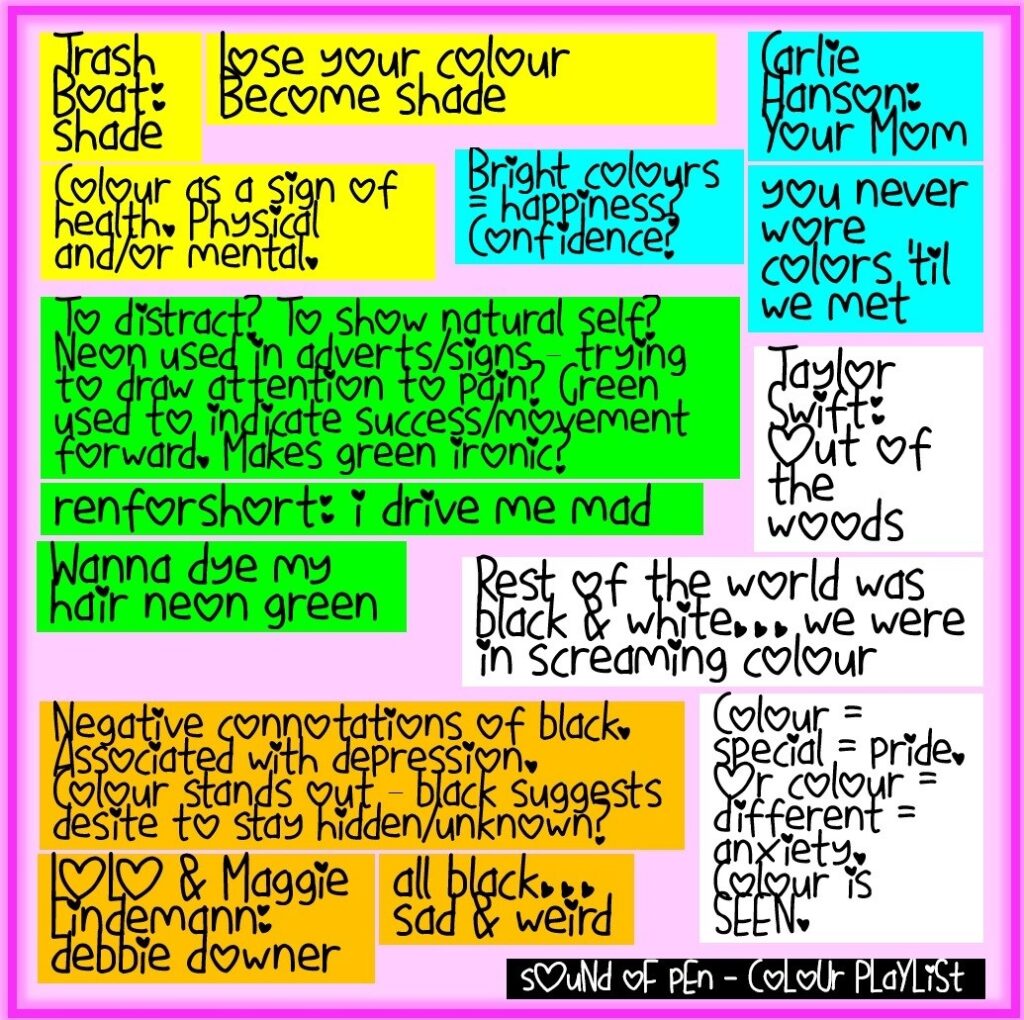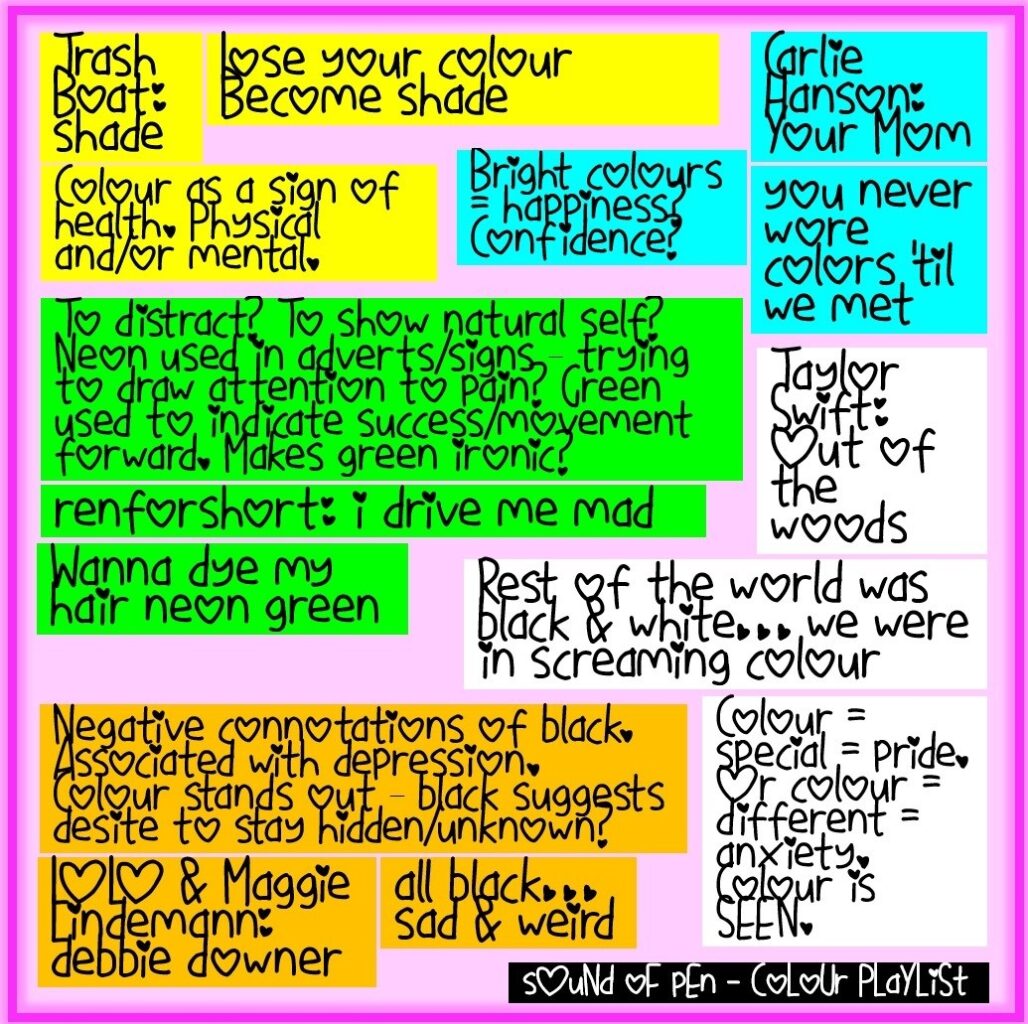A lot of songwriters make use of colour in their lyrics – and some of those artists employ blacks, whites, greens, pinks etc. as potently as actual painters. Here are the 10 songs that make the most impressive, inspired use of tints and tones!
- MUSIC FOCUS: Everything from Coldplay to My Chemical Romance to Dave!
- ACTIVITY FOCUS: Explore the significance of the colour within some brilliant songs. Then, consider how the ideas you come up with feel relevant to the texts you’re studying at school. ALL the texts you’re studying at school make some use of colour. Why do the writers choose to colour the work in the way they do?
10. girlfriends: ‘Tattoo’
‘Love scars and black hearts, and lyrics on my chest
Birthdays, my mom’s name, and words I won’t forget’
We’re familiar with the idea that the presence of the colour ‘black’ is often an indicator that something dark is occurring. In recent years, though, our favourite artists have been celebrating that darkness. Not because they’re trying to scare you, but because they’re proud of the way they’re dealing – or have dealt – with bad times and difficult challenges. When you come across the colour black in your course texts, maybe it does connote a threatening darkness. But maybe sometimes it suggests courage too.
9. Enter Shikari, ‘Sorry You’re Not A Winner’
‘My white abode, do you remember?’
Maybe Rou Reynolds is simply singing about a lovely white house he used to live in. Doesn’t quite sound like Enter Shikari, though, does it? Perhaps, then, this lyric serves as some kind of comment on the unreliable promise of something akin to The American Dream. Lots of the texts you’re reading will explore the idea that, for most people, any kind of bright future has more to do with gambling that guarantees. Whatever the case, Enter Shikari remind us to investigate whiteness. Does it symbolise a former state of purity? Or an ideal only available to the white characters in your text? Or to a genuine innocence? Or something else?
8. My Chemical Romance: ‘Welcome To The Black Parade’
‘He said, “Will you defeat them?
Your demons, and all the non-believers
The plans that they have made?”
“Because one day, I’ll leave you a phantom
To lead you in the summer
To join the black parade”‘
‘Welcome To The Black Parade’ changed EVERYTHING when it flew to number one in the charts. It seems crazy now that the band were maligned for investigating their own misery in a way that, in 2022, we’re encouraged to. These days, way more people understand that the blackness isn’t something to be shoved into the corner. It’s to be faced. The generation-defining MCR were instrumental in changing the world’s perspective in a way that’s proved beneficial to so many people’s mental health.
7. Coldplay: ‘Yellow’
‘I wrote a song for you
And all the things you do
And it was called Yellow‘
We love Coldplay‘s ‘Yellow’ because it underlines the multi-dimensional nature of colour. In Chris Martin’s world, ‘Yellow’ kind of stands for whatever you want it to stand for. And so it is that the band’s listeners can interact with the song on their own terms – just as they would with the colour yellow itself. Somewhat paradoxically, then, the song’s abstract nature allows any individual from any walk of life to connect to it in a really specific, personal way. When exploring colour within your core texts, consider the fact that each colour means something different to every person looking at it – and also the fact that colour is EVERYWHERE!
6. Trash Boat: ‘Shade’
‘Now your bright and blinding light begins to fade
Lose your colour
Become shade’
Trash Boat suggest that there’s a correlation between losing colour and diminishing health. Maybe you’ll notice – in your course text, or a previously unseen piece of prose – that, for example, a character’s wardrobe is becoming less and less colourful. Based on the thinking you’ve already done in relation to Trash Boat’s ‘Shade’, you’ll now be able to note that, perhaps, the author is encouraging us to pick up on a problem affecting that character.
5. Carlie Hanson: ‘Your Mom’
‘Your mom told me you never wore colours ’til we met
Hangin’ pictures on your wall that you once painted black‘
Carlie Hanson contrasts the walls her lover used to paint black with the bright colours that same lover now wears. Let’s look, then, not just for colours acting in their own independent way, but at other colours nearby. By positioning different colours in close proximity to each other, the writer might be encouraging us to notice some kind of significant change in a character’s feeling or a shift in atmosphere.
4. Taylor Swift: ‘Out Of The Woods’
‘You took a Polaroid of us
Then discovered
(Then discovered)
The rest of the world was black and white
But we were in screaming colour‘
Taylor Swift explores the contrast between black, white and more rainbow-friendly colours. Perhaps the black and white ideas represent an archaic way of thinking (a thread that will feel relevant to any texts concerned with race). Equally, the ‘screaming’ could hint at the noise, and perhaps pain, inherent in pushing against embedded beliefs and systems.
3. renforshort: ‘i drive me mad’
‘Some days I wake up and I feel like I just wanna
Dye my hair neon green
So, I can forget I’m me’
renforshort‘s use of green is really interesting. Yes, we know green often represents growth. But what if someone is using that colour green with the deliberate intention of misleading the people around them? Are any of your characters wearing green? If so, are they really healthy? Are they genuinely being the most natural version of themselves? Or is the colour green actually being used as some kind of cover?
2. LOLO x Maggie Lindemann: ‘debbie downer’
‘They’re like, “Brr, it’s cold in here, she suck the life outta your atmosphere”
I said, “Brr, it’s cold in here”, all black, everything sad and weird’
Understanding the typical connotations of that colour black is again important when thinking about ‘debbie downer’. Our first instinct might be to link the colour black to depression and darkness, but darkness (blackness) is also mysterious. And so maybe we should ask ourselves if there’s more going on beneath the blackness than we first notice. What point do you think LOLO and Maggie Lindemann are making about the people who judge ‘debbie downer’ based on the colour of her outfit? Consider, too, those characters making superficial judgements within your course texts.
1. Dave: ‘Black’
‘Black is bein’ strong inside and facing defeat’
Some of the tracks on this list can be listened to with a light heart – you don’t HAVE to get involved in thinking about ‘colour’ if you don’t want to. That is not the case with Dave’s ‘Black’. Watching him deconstruct the meaning of ‘black’ will help you to understand how multi-layered the best language analysis can be – and how important it is that we explore ideas about colour with absolute care.
ACTIVITY 1
Think about how any of these ideas feel relevant to the texts you’re studying. Please let us know about any connections you make – we’d love to publish them here and give you the credit you deserve! Your ideas don’t need to necessarily link specifically to the thoughts we’ve shared above – we want to hear about ANYTHING related to colour in your GCSE/A-Level texts!! Maybe you love the use of colour in a song by YUNGBLUD and want to tell us how it links to the use of colour in ‘The Great Gatsby’! Whatever tracks or texts you’re thinking about, we would to love to hear ALL OF YOUR IDEAS! You can look at the picture and notes below to help you get started.

Trash Boat suggest there’s a correlation between losing colour and diminishing health. Maybe you’ll notice – in your course text, or a previously unseen piece of prose – that a character’s wardrobe is becoming less and less colourful. Based on the thinking you’ve already done in relation to Trash Boat’s ‘Shade’, you’ll now be able to note that, perhaps, the author is encouraging us to pick up on a problem affecting that character.
Carlie Hanson contrasts the walls her lover used to paint black with the bright colours that same lover now wears. Let’s look, then, not just for colours acting in their own independent way, but at other colours nearby. By positioning different colours in close proximity, the writer might be encouraging us to notice some kind of significant change in a character’s feeling or a shift in atmosphere.
Taylor Swift explores the contrast between black and white too. Perhaps the black and white ideas represent an archaic way of thinking (a thread that will feel relevant to any texts concerned with race) – but equally the ‘screaming’ could hint at the noise, and perhaps pain, inherent in pushing against embedded beliefs and systems.
renforshort‘s use of green is really interesting. Yes, we know green often represents growth. But what if someone is using that colour green with the deliberate intention of misleading the people around them? Are any of your characters wearing green? If so, are they really healthy? Are they genuinely being the most natural version of themselves? Or is the colour green actually being used as some kind of cover?
Understanding the typical connotations of a colour are equally important when looking at ‘debbie downer‘. It might feel appropriate to link the colour black to depression and darkness, but darkness (blackness) is also mysterious. What comment are LOLO/Maggie Lindemann making about the people who think they can judge Debbie Downer based on the colour of her outfit? Ask the same question of the characters making superficial judgements within your course texts.
This class was created with the help of Indio Cahillane.
Next, you can have a go at analysing darkness with Linkin Park, BMTH & Enter Shikari.

